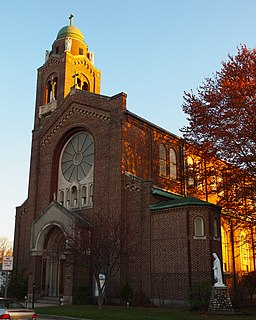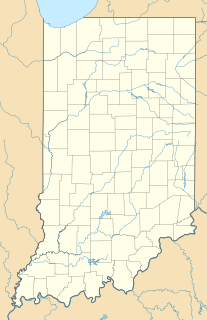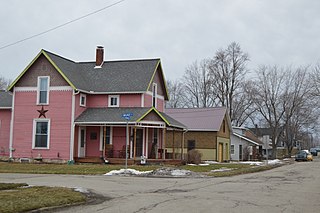
Chatham–Arch is a neighborhood located immediately east of Downtown Indianapolis, Indiana, United States. This neighborhood is one of the oldest in Indianapolis, dating back to the mid 19th century. Chatham–Arch contains many of Indianapolis's historic homes.

The East Spring Street Historic District is a national historic district located at New Albany, Indiana. The general area is E. Fifth Street to the west, Spring St. to the north, E. Eighth Street to the east, and Market Street to the south. The Cedar Bough Place Historic District is one block north of the area, the New Albany Downtown Historic District is immediately west of the area, and the Market Street section of the Mansion Row Historic District starts. The district encompasses 84 contributing buildings in a largely residential section of New Albany. It developed in the late-19th and early-20th century and includes notable examples of Queen Anne and Italianate style architecture. Notable buildings include the Third Presbyterian Church, St. Mary's Roman Catholic Church and Rectory, the former John Conner House or Masonic Lodge, and Edwards City Hospital.

The Howard Park Historic District is a national historic district located at South Bend, St. Joseph County, Indiana. It encompasses 27.6-acres and includes 51 contributing buildings, 2 additional contributing structures, and 1 further contributing site. It developed between about 1880 and 1947, and includes notable examples of Queen Anne, Colonial Revival, Renaissance Revival, Prairie School, and Bungalow / American Craftsman style architecture and works by architects Austin & Shambleau. Notable buildings include the Sunnyside Apartments (1922), Studebaker / Johnson House (1907), Zion Evangelical Church, the Works Progress Administration built Howard Park Administrative Building (1940), and Lister / Plotkin House (1882).

St. Casimir Parish Historic District is a national historic district located at South Bend, St. Joseph County, Indiana. The district encompasses 321 contributing buildings in a predominantly residential section of South Bend centered on St. Casimir Roman Catholic Church. It developed between about 1880 and 1945, and includes notable examples of Queen Anne, Romanesque Revival, Renaissance Revival, and Bungalow / American Craftsman style architecture. Notable buildings include the St. Casimir Church (1924-1925).

St. Vincent Villa Historic District is a national historic district located at Fort Wayne, Indiana. The district encompasses nine contributing buildings and one contributing site associated with a Catholic orphanage. The buildings were constructed between 1932 and 1950–1951, and include notable examples of Mission Revival, Romanesque Revival, and Bungalow / [[AFort Wayne Newspapers American Craftsman]] style institutional architecture. They include the Main Building (1932), four cottages, the Boiler House (1932), and two bungalows. The property was sold by the Roman Catholic Diocese of Fort Wayne–South Bend to the YWCA of Fort Wayne in the 1970s.

Hohman Avenue Commercial Historic District is a national historic district located at Hammond, Lake County, Indiana. The district encompasses 15 contributing buildings in the central business district of Hammond. It developed between about 1904 and 1956, and includes notable example of Romanesque Revival, Classical Revival, and Colonial Revival style architecture. Notable buildings include Knott's Apartments (1904), Emmerling Ambulance Garage (1918), Emmerling Building (1918), St. Joseph's Roman Catholic Church Complex, LaSalle Hotel, OK Building (1913), and the Hammond National Bank.

Plymouth Downtown Historic District is a national historic district located in Plymouth, Marshall County, Indiana, United States. The district encompasses 47 contributing buildings and one contributing structure in the central business district of Plymouth. It developed between about 1870 and 1940, and includes examples of Italianate, Romanesque Revival, and Colonial Revival style architecture. Located in the district is the separately listed Plymouth Fire Station. Other notable buildings include the Montgomery Ward Building (1929), Metsker Block, Rentschler Building (1910), Early Plymouth Post Office (1884), First National Bank-Plymouth City Hall, Packard Bank Block (1879), Simons Building (1895), Wheeler Block, Bank Block, Bank Block-Masonic Temple (1901), Plymouth Post Office (1935), and Plymouth Motor Sales (1929).

Ellettsville Downtown Historic District is a national historic district located at Ellettsville, Monroe County, Indiana. The district encompasses 50 contributing buildings in the central business district and surrounding residential sections of Ellettsville. It developed between about 1840 and 1953, and includes notable examples of Queen Anne, Early Commercial, Gothic Revival, and Bungalow/American Craftsman style architecture. Notable buildings include the Robert Stimson House, May Presley House, Bradford House, George W. Fletcher House, Wickens House (1909), Capt. Gilbert Perry House, I.O.O.F. Building, Town Hall (1927), Masonic Building (1895), Knights of Pythias Building, First United Methodist Church (1900), and First Baptist Church (1909).

South Bend Remedy Company Building is a historic building located at South Bend, St. Joseph County, Indiana. It was built in 1895, and is a two-story, transitional Queen Anne / Classical Revival style brick and limestone building. It features a recessed entrance, round turret topped by a conical roof, and a wide frieze band of garlands and torches. It was built to house the offices and laboratory for the South Bend Remedy Company, a mail order patent medicine business. It was moved to 501 W. Colfax Ave. in 1988, and then to 402 W. Washington St. in 2003.

Third St. Joseph County Courthouse is a historic courthouse located at South Bend, St. Joseph County, Indiana. It was designed by architecture firm Shepley, Rutan and Coolidge and built in 1897. It is a 2+1⁄2-story, Classical Revival style stone and granite building. It features a large dome at the cross-axis of the gable roof, a paired column portico, and center pavilion and clock in the tympanum of the pediment.

Old Courthouse, also known as the Second St. Joseph County Courthouse, is a historic courthouse located at South Bend, St. Joseph County, Indiana. It was designed by architect John M. Van Osdel (1811-1891) and built in 1853. It is a two-story, Greek Revival style stone building. The building measures 61 feet wide and 93 feet deep. It features a projecting front portico supported by Doric order columns and a front gable roof topped by a cupola. It was moved to its present site in 1896. Following construction of the Third St. Joseph County Courthouse, the building housed the local G.A.R. chapter and historical museum. The building now houses office of the Traffic and Misdemeanor Court and Small Claims Court.

Chapin Park Historic District is a national historic district located at South Bend, St. Joseph County, Indiana. It encompasses 260 contributing buildings and 3 contributing sites immediately north of downtown South Bend. Most of its development occurred between about 1890 and 1910 on land formerly comprising the estate of Horatio Chapin, an early settler of South Bend. The neighborhood includes examples of Second Empire, Queen Anne, and Gothic Revival style architecture. Notable buildings include the Horatio Chapin House, Judge Andrew Anderson House, Hodson's Castle (1888), South Bend Civic Theater (1898), YMCA (1928), and Christian Science Church (1916).

East Washington Street Historic District is a national historic district located at South Bend, St. Joseph County, Indiana. It encompasses 71 contributing buildings and 1 contributing structure in a predominantly residential section of South Bend. It developed between about 1880 and 1947, and includes notable examples of Italianate, Colonial Revival, American Foursquare, and Bungalow / American Craftsman style architecture and works by architects Austin & Shambleau. Notable buildings include the James and Marie Zimmerman House (1921), Eger House (1911), George and Emma Hewitt House (1905), Ruth and Edwin H. Sommerer House (1930), Chauncey T. Fassett House (1898), Dougdale Carriage Barn (1900), and Sunnyside Presbyterian Church.

Colonial Gardens Commercial Historic District is a national historic district located at South Bend, St. Joseph County, Indiana. It encompasses four contributing buildings on a commercial strip in South Bend. It developed between about 1925 and 1947, and includes notable examples of Classical Revival style architecture. The buildings are tan brick commercial buildings with terra cotta trim. They include the former River Park Theater (1927) and Colonial Building.

West LaSalle Avenue Historic District is a national historic district located at South Bend, St. Joseph County, Indiana. It encompasses 33 contributing buildings and 2 contributing structures in a predominantly residential section of South Bend. It developed between about 1870 and 1930, and includes notable examples of Italianate, Queen Anne, Late Gothic Revival, and Beaux-Arts style architecture and works by architects Austin & Shambleau. Notable buildings include the St. Peter's Church (1927), Frank Eby House (1904), Lydia Klinger House (1900), Woodworth House, Woolman House (1880), Goetz House (1892), Studebaker House, Kuppler House (1885), and the Gunderman House.

West Side Historic District is a national historic district located at Shelbyville, Shelby County, Indiana. The district encompasses 373 contributing buildings and 4 contributing structures in a predominantly residential section of Shelbyville. It developed between about 1853 and the 1939, and includes notable examples of Queen Anne, Colonial Revival, and Stick Style / Eastlake movement style architecture. Located in the district is the separately listed John Hamilton House. Other notable buildings include the Peter Metzger House, Joseph Acre House, Earl Karmire House, Charles Davis House, Charles Birely House, Harry Whitcomb House, First Christian Church (1901), C.H. Campbell House, George McConnell House, First Presbyterian Church (1885), John Randall House, Alfred Major House, Frank C Sheldon House, and Edward Thurston House.

Ninth Street Hill Neighborhood Historic District is a national historic district located at Lafayette, Tippecanoe County, Indiana. The district encompasses 88 contributing buildings and 6 contributing structures in a predominantly residential section of Lafayette. It developed between about 1850 and 1946 and includes representative examples of Gothic Revival, Italianate, Queen Anne, Greek Revival, and Second Empire style architecture. Located in the district is the separately listed Judge Cyrus Ball House. Other notable contributing resources include the Samuel Moore House (1891), Moore-Porter-Boswell House (1895), Stanley Coulter House (1890), Edward Bohrer House (1909), Thomas Wood House, Job M. Nash House (1859), and Gordon Graham House.

West Wabash Historic District is a national historic district located at Wabash, Wabash County, Indiana. It encompasses 283 contributing buildings in a predominantly residential section of Wabash. It developed between about 1840 and 1930, and includes representative examples of Federal, Italianate, Romanesque Revival, and Colonial Revival style architecture. Located in the district is the separately listed First Christian Church. Other notable buildings include the Jackson Family House, John and Lucinda Sivey House, Thomas and Hannah Whiteside House (1881), Matlock-Barnhart House (1866–1867), Alexander and Millicent Hill House, David and Sadie Cohen House (1909), Bennett E. Davis House (1842), Presbyterian Church (1881), Wabash Carnegie Public Library, and Wabash High School.

East Wabash Historic District is a national historic district located at Wabash, Wabash County, Indiana. It encompasses 204 contributing buildings in a predominantly residential section of Wabash. It developed between about 1850 and 1930, and includes representative examples of Federal, Italianate, Second Empire, Queen Anne, Colonial Revival, and Bungalow / American Craftsman style architecture. Notable buildings include the George and Sophie Lumaree House, Treaty Stone and Lime Company (1887), Grandstaff Hentgen Funeral Service, James D. Conner House, Cowgill House, Kaiser Hotel, C.W. Cowgill House (1850), and St. Matthew's Evangelical and Reformed Church.

LaFontaine Historic District is a national historic district located at La Fontaine, Wabash County, Indiana. It encompasses 56 contributing buildings and 4 contributing structures in the central business district and surrounding residential sections of La Fontaine. It developed between about 1848 and 1930, and includes representative examples of Gothic Revival, Italianate, Queen Anne, Romanesque Revival, Classical Revival, and Bungalow / American Craftsman style architecture.
























